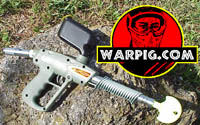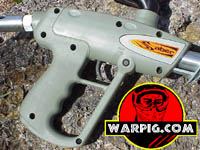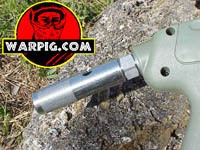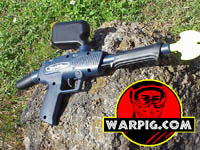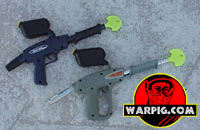
|
by Bill Mills With the strong commercial success of the Talon, Brass Eagle has moved forward to release its next generation of low-cost, mass marketed pump action paintball guns. Like the Talon before them, the Saber and Blade are based on the original Nel Spot valve design. Their valve bodies are die cast, with machined power tubes, and hammers, while the bolt is a high impact polymer with a metal insert designed to engage the sear. The molded polymer trigger is ramped to allow for auto-triggering. A new and unique feature to these paintguns is the anti-theft device. The retail store packaging includes a message which reads "SHOPLIFTERS - This Product Contains an Electronic Anti-theft Device!" Since we didn't see one in the packaging, we thought it referred to stores putting anti-theft tags on the package. Wrong - inside the grip frame is a small anti-theft tag, designed to be detected by the doorway sensors found in most major mass merchants. Both of these new pumps feature a very different style than paintball players are used to. The overall shapes were developed through market testing in which the target audience of young, potential paintball players (note: not experienced players) were shown a variety of mock-ups and asked which appealed to them. So far, our suggestion that either model be molded in primary colors and called "My First Paintball Shooter" has been widely ignored. Both of these new pumps have a center feed port, which is unusual for pump paintguns, but popular in market testing. The receivers are of a two piece molded plastic design, held together by a number of phillips head screws. Both bodies feature indentations to allow the mounting of an as yet unreleased sight rail. Of the two paintguns, the Blade is the lower end model. It features a fixed plastic barrel, and a rear 12 gram changer. The Saber is a bit more versatile with a rear ASA connector. It can accept a back bottle tank, or be used with the included 12-gram adapter. It's threaded aluminum barrel can be removed for cleaning. The Blade manual makes no mention of thread specifications, or barrel removal for that matter. The threads look like Worr Games Products Autococker style threads, and an original Rainmaker (WGP threads) barrel fit in the Saber, but a number of after market 'Cocker barrels from Smart Parts, Barrels of America, and J&J which we tried, did not fit. This is probably not of a major concern to the average Saber owner since those barrels cost substantially more than the 'gun itself. The Saber is also distinct from the Blade in that it features a full cutlass style trigger guard, with a separator that splits the trigger out from the other fingers. Its final significant difference is that it includes a velocity adjustable bolt. A "down the barrel" style velocity tool (included) changes tension on the hammer spring. Packed with each of these new 'guns is a barrel plug and 45 round box style loader with single ball width cap (very reminiscent of the old 10 round tube days). The retail packaging is a clear vacuum molded clamshell, and the same package has different protrusions to allow it to hold both 'guns. As an interesting predictor, there is a protrusion forward of either of the two 'guns feed ports, and a protrusion in the right place for a vertical ASA connector, indicating the likely hood of a new low cost model in the near future. Probably the most prominent feature of the new 'guns is their price. The Blade (Model 2010) is set to retail for $24.99, and the Saber (Model 2020) is expected to retail around $52. |
